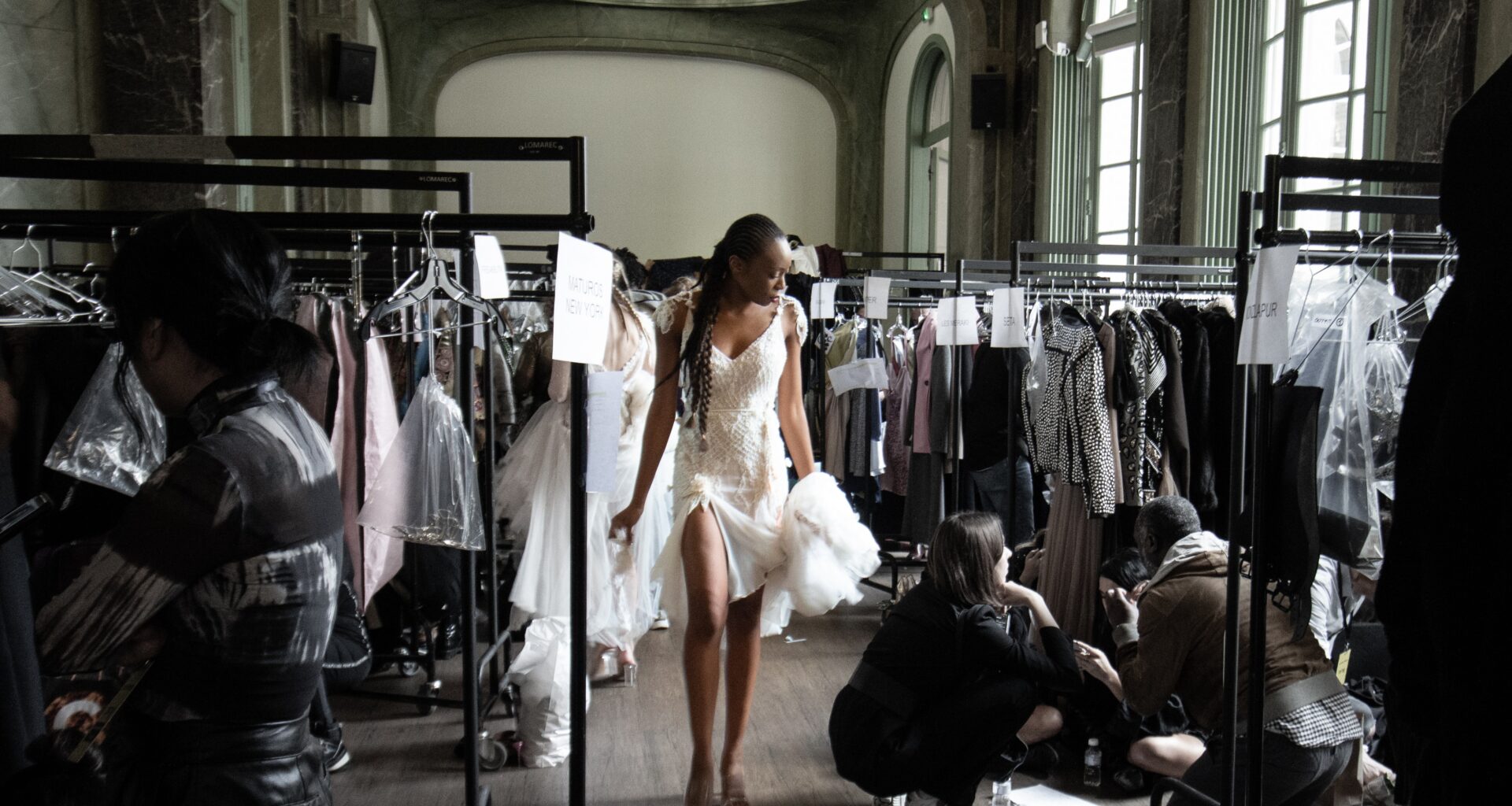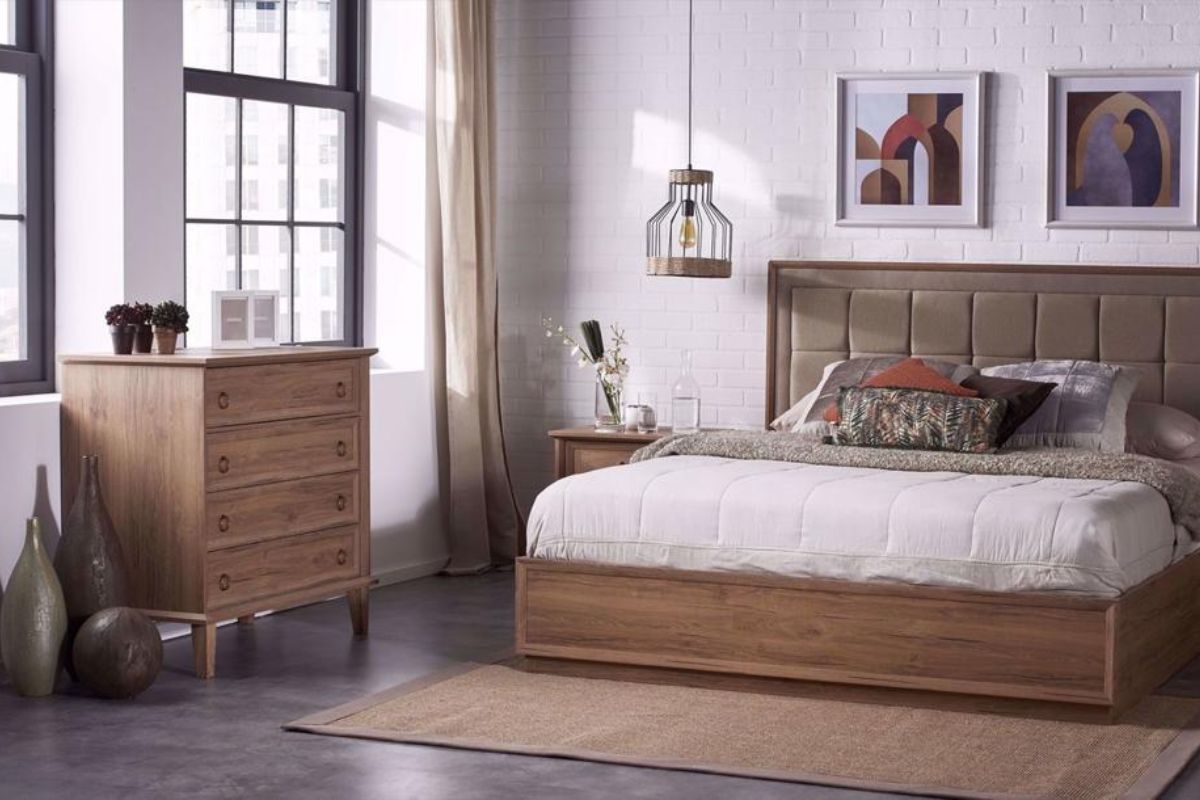Home>Garden Essentials>Garden Storage>How To Become A Wardrobe Stylist


Garden Storage
How To Become A Wardrobe Stylist
Modified: February 24, 2024
Learn the essential steps to become a wardrobe stylist, including expert tips on organization, storage solutions, and maximizing space.
(Many of the links in this article redirect to a specific reviewed product. Your purchase of these products through affiliate links helps to generate commission for Storables.com, at no extra cost. Learn more)
Introduction
Welcome to the exciting world of wardrobe styling! If you have a passion for fashion and love helping people look their best, then becoming a wardrobe stylist might be the perfect career choice for you. Wardrobe stylists play a crucial role in the fashion industry by curating and creating outfits that suit their client’s personal style, body type, and occasion.
From working with celebrities for red carpet events to assisting everyday individuals in revamping their wardrobes, wardrobe stylists have the power to transform a person’s image and boost their confidence. In this article, we will explore the ins and outs of becoming a wardrobe stylist, including the necessary skills and education required, how to build your portfolio, ways to network and gain experience, and much more.
Whether you’re considering a career change or just starting in the fashion industry, this guide will provide you with valuable insights and tips to help you succeed as a wardrobe stylist. So, let’s dive in and unlock the secrets to becoming a sought-after wardrobe stylist!
Key Takeaways:
- Becoming a successful wardrobe stylist requires a combination of technical skills, creativity, and an understanding of fashion trends. Continuous learning, hands-on experience, and a strong portfolio are essential for thriving in this competitive industry.
- Effective communication, empathy, and a commitment to delivering exceptional service are crucial when working with clients and navigating challenges. While certification can provide credibility, experience, a strong portfolio, and dedication to continuous improvement are equally valuable in establishing a successful career as a wardrobe stylist.
Read more: What Is A Wardrobe Stylist
What is a Wardrobe Stylist?
A wardrobe stylist is a fashion professional who specializes in creating and coordinating outfits for individuals or events. They have a keen eye for fashion trends, an understanding of different body types, and the ability to communicate personal style through clothing choices. Wardrobe stylists work closely with clients to curate looks that reflect their unique personality, enhance their image, and meet the requirements of specific occasions.
Wardrobe stylists can work in various settings, including personal styling, photo shoots, fashion shows, film and television, and editorial work. In personal styling, wardrobe stylists work one-on-one with clients to assess their style goals, evaluate their existing wardrobe, and create new looks by incorporating both existing and new clothing pieces. They consider factors such as the client’s body shape, skin tone, and lifestyle to craft outfits that are both functional and fashionable.
In the realm of photo shoots, wardrobe stylists collaborate with photographers, models, and hair and makeup artists to bring a specific vision to life. They carefully select garments, accessories, and footwear that complement the theme, mood, and concept of the shoot. Fashion shows require wardrobe stylists to create cohesive and visually appealing outfits for models to present on the runway. They often work closely with designers and event organizers to ensure that the garments showcased are styled to perfection.
Wardrobe stylists in the film and television industry work on creating the entire wardrobe for characters, ensuring that each outfit accurately reflects the character’s personality and story arc. Editorial stylists collaborate with photographers, art directors, and creative teams to create visually striking images for magazines and other publications.
Being a wardrobe stylist requires a combination of creativity, organization skills, and a strong sense of aesthetics. Effective communication and the ability to understand and meet the client’s needs are essential. A well-executed wardrobe styling can greatly impact a person’s confidence and self-image, making it a rewarding and fulfilling career path.
Skills and Education Required
Becoming a successful wardrobe stylist requires a combination of technical skills, creativity, and an understanding of fashion trends. While a formal education is not always a requirement, obtaining relevant training and developing certain skills can greatly enhance your chances of success in this highly competitive industry.
Here are some of the essential skills and education that can help you excel as a wardrobe stylist:
- Fashion Knowledge: A deep understanding of fashion trends, designers, and clothing brands is crucial. Stay updated with the latest fashion publications, attend fashion shows, and immerse yourself in the industry to develop a strong fashion sense.
- Styling Techniques: Learn and master various styling techniques, such as layering, accessorizing, and color coordination. Understand how different clothing silhouettes work on different body types to create flattering looks.
- Attention to Detail: Pay close attention to details like fit, fabric quality, and overall aesthetic. Small details can make a significant difference in the final look, so it’s essential to have a keen eye for detail.
- Interpersonal Skills: As a wardrobe stylist, you’ll work closely with clients, designers, photographers, and other industry professionals. Good communication skills, the ability to listen and understand client needs, and collaboration skills are essential in building successful working relationships.
- Organizational Skills: Wardrobe stylists often need to manage and organize clothing inventory, props, and accessories. Excellent organizational skills will help you keep track of your wardrobe pieces and stay on top of your styling assignments.
- Knowledge of Body Types: Understanding different body shapes and how to dress them in the most flattering way is crucial in wardrobe styling. Learn how to highlight the client’s best features and create balance through clothing choices.
While a formal education is not mandatory, pursuing a degree or certification in fashion design, fashion merchandising, or fashion styling can provide you with a strong foundation of knowledge and skills. These programs often cover topics like garment construction, fashion history, fashion trends, and visual merchandising.
Additionally, gaining hands-on experience through internships or apprenticeships with established wardrobe stylists or fashion houses can be highly beneficial. This will provide you with practical experience, industry connections, and insights into the day-to-day operations of a wardrobe stylist.
Remember that continuous learning and staying updated with the latest fashion trends are essential to thrive in this industry. Attend workshops, seminars, and industry events to expand your knowledge and network with other professionals. With the right combination of skills and education, you’ll be well on your way to a successful career as a wardrobe stylist.
Building Your Portfolio
A strong portfolio is crucial for showcasing your skills and attracting potential clients as a wardrobe stylist. Your portfolio serves as a visual representation of your work and demonstrates your ability to create cohesive and stylish outfits.
Here are some tips to help you build an impressive portfolio:
- Start with Personal Projects: If you’re just starting, you can begin by styling friends or family members for personal photoshoots. This will allow you to experiment with different styles, showcase your creativity, and build a diverse range of looks for your portfolio.
- Collaborate with Photographers and Models: Reach out to photographers and models who are also building their portfolios and propose collaboration. Collaborative photoshoots provide an opportunity to work with other creative individuals and create professional-looking images for your portfolio.
- Consider TFP/TFCD: Time for Print (TFP) or Time for CD (TFCD) arrangements allow you to collaborate with photographers and models, usually on a non-paid basis, where everyone involved benefits from the final images. It’s a win-win situation that helps all parties build their portfolios.
- Highlight Diversity: Include a variety of styles, looks, and body types in your portfolio to demonstrate your versatility as a wardrobe stylist. Show that you can adapt your skills to meet the needs of different clients and occasions.
- Include Before and After Shots: Showcase the transformative power of your styling by including before and after shots in your portfolio. This demonstrates your ability to enhance a person’s image through strategic clothing choices.
- Showcase Various Settings: Your portfolio should include examples of your work in different settings, such as casual, formal, professional, and themed events. This will help potential clients envision how you can style them for various occasions.
- Keep it Updated: Regularly update your portfolio with your latest work. As you gain more experience and undertake new projects, replace older images with fresh and improved ones.
Remember to organize your portfolio in a visually appealing and user-friendly manner. Whether you choose to create a physical portfolio or an online platform such as a website or social media page, ensure that it is easy for potential clients to navigate and view your work.
Building a strong portfolio takes time and effort, but it is a crucial step in establishing yourself as a credible and talented wardrobe stylist. Focus on showcasing your unique style and abilities, and let your portfolio speak for itself.
Networking and Building Connections
In the world of wardrobe styling, networking and building connections are essential for finding job opportunities and establishing a strong reputation. Building a network of contacts in the fashion industry can open doors to collaborations, referrals, and valuable insights. Here are some ways to network and build connections as a wardrobe stylist:
- Attend Fashion Events: Fashion shows, industry conferences, and trade shows provide excellent networking opportunities. Attend these events to meet industry professionals, designers, photographers, models, and other wardrobe stylists. Engage in conversations, exchange business cards, and follow up with individuals you connect with.
- Join Professional Organizations: Join fashion or styling associations and organizations to connect with like-minded individuals in the industry. These organizations often organize networking events, seminars, and workshops that can help you expand your network and stay updated with industry trends.
- Utilize Social Media: Create a professional presence on social media platforms like Instagram, LinkedIn, and Facebook. Showcase your work, engage with others in the industry, and use relevant hashtags to reach a wider audience. Follow and connect with industry professionals, brands, and influencers to build your online network.
- Collaborate with Other Creatives: Collaborate with photographers, makeup artists, hairstylists, and models to create strong working relationships. By working together on projects, you can create a supportive network and refer each other to potential clients or opportunities.
- Assist Established Stylists: Reach out to well-established wardrobe stylists and offer your assistance as a stylist’s assistant. Assisting experienced professionals is an excellent way to learn from them, gain valuable hands-on experience, and build connections in the industry.
- Attend Workshops and Seminars: Participate in workshops, seminars, and educational events specifically designed for wardrobe stylists. Not only will you learn new skills and techniques, but you’ll also have the opportunity to network with fellow stylists and industry experts.
- Stay Connected and Follow Up: After meeting and connecting with professionals or potential clients, follow up with them. Send a personalized message or email to express your interest in working together or maintaining a relationship. Stay connected and keep them updated with your latest work and projects.
Networking is a continuous process, and it’s important to be proactive and maintain relationships. Building strong connections within the industry can lead to collaborations, referrals, and even job opportunities that may not be advertised publicly.
Remember, networking is not just about what others can do for you. It is a two-way street, so be open to supporting and helping others in your network as well. By building genuine relationships and actively engaging within the industry, you increase your chances of success as a wardrobe stylist.
Read more: How Much Does A Wardrobe Stylist Make
Gaining Experience
Gaining real-world experience is crucial for a wardrobe stylist to develop their skills, expand their portfolio, and establish their credibility in the industry. While education and training provide a solid foundation, hands-on experience will help you refine your craft and build a network of industry professionals. Here are some ways to gain valuable experience as a wardrobe stylist:
- Internships: Look for internships with fashion magazines, styling agencies, or established wardrobe stylists. Internships provide invaluable opportunities to learn from professionals, assist with photoshoots, and gain practical knowledge of the industry.
- Assisting Other Stylists: Reach out to experienced wardrobe stylists and offer your assistance as a stylist’s assistant. Assisting established professionals not only allows you to learn from their expertise but also helps you build connections and credibility within the industry.
- Collaborative Projects: Collaborate with photographers, models, and makeup artists to work on creative projects. These collaborations can help you build your portfolio, experiment with different styles, and gain hands-on experience in a supportive environment.
- Volunteer Opportunities: Look for volunteer opportunities in fashion events, charity fundraisers, or local fashion shows. Volunteering allows you to gain experience, network with industry professionals, and contribute to the fashion community.
- Personal Projects: Initiate personal projects to showcase your styling skills and creative vision. Style friends or family members for photoshoots, create themed lookbooks, or volunteer to style for local fashion bloggers. These projects allow you to demonstrate your unique style and build a diverse portfolio.
- Participate in Fashion Competitions: Enter fashion styling competitions and challenges to push your creative boundaries and gain exposure. Competitions provide opportunities to work with professional models, photographers, and designers, and can bolster your reputation as a stylist.
- Continuing Education: Take advantage of workshops, seminars, and online courses that focus on specific styling techniques or industry-related topics. Continuing education allows you to stay updated with new trends and expand your knowledge and skills as a wardrobe stylist.
Remember that gaining experience takes time and persistence. Be open to learning from every opportunity and continuously seek out ways to improve your skills. The more hands-on experience you accumulate, the more confident and competent you will become as a wardrobe stylist.
Additionally, as you gain experience, don’t forget to update your portfolio and highlight your most recent and impressive work. Your portfolio serves as a visual representation of your abilities and will play a crucial role in attracting potential clients and job opportunities in the future.
Assisting Other Wardrobe Stylists
One of the most valuable ways to gain experience and refine your skills as a wardrobe stylist is by assisting established professionals in the industry. Assisting other wardrobe stylists provides a unique opportunity to learn firsthand from experienced professionals, observe their workflows, and build a network of industry connections. Here are some benefits of assisting other wardrobe stylists:
- Learning from Experts: Assisting seasoned wardrobe stylists allows you to learn industry best practices, styling techniques, and organizational skills. You can observe their creative process, see how they work with clients, and gain insights into their decision-making process.
- Hands-on Experience: Assisting professionals on photoshoots, fashion shows, or other styling projects provides valuable hands-on experience. You’ll gain exposure to working with various clients, understanding their needs, and problem-solving in real-time situations.
- Building Industry Connections: Assisting established wardrobe stylists allows you to network and build connections within the industry. You’ll have the opportunity to connect with photographers, models, makeup artists, hairstylists, and other industry professionals who are also part of the team.
- Expanding Your Portfolio: Assisting other wardrobe stylists often involves helping to create looks and outfits. This exposure enables you to add these projects to your portfolio and demonstrate your versatility and collaboration skills.
- Gaining Professional Guidance: Assisting wardrobe stylists provides an opportunity to receive feedback and guidance from experienced professionals. They can offer insights, advice, and constructive criticism to help you grow and improve as a stylist.
- Understanding the Industry: By working with established wardrobe stylists, you’ll gain a deeper understanding of the industry dynamics, client expectations, and the business side of wardrobe styling. This knowledge is invaluable when starting your own career as a wardrobe stylist.
To find opportunities to assist other wardrobe stylists, reach out to them directly through professional networking events, social media platforms, or through referrals from industry connections. Be proactive in expressing your interest and willingness to assist them, showcasing your passion for the industry and your eagerness to learn.
While assisting other stylists, be professional, attentive, and adaptable. Take on tasks with enthusiasm, attention to detail, and a willingness to contribute to the team’s success. Building a reputation for reliability, professionalism, and a strong work ethic can lead to more significant opportunities in the future.
Keep in mind that assisting other stylists is not about competition but about learning and growing. Embrace the opportunity to contribute to their projects, learn from their expertise, and build meaningful connections within the industry. Through assisting, you’ll gain valuable experience and invaluable insights that will further your journey as a successful wardrobe stylist.
Choosing a Niche
As a wardrobe stylist, choosing a niche can set you apart from the competition and help you become known for your expertise in a specific area. A niche allows you to focus your skills, target a specific audience, and establish yourself as an authority in that particular field. Here are some considerations to help you choose a niche:
- Identify Your Interests and Passions: Start by identifying the aspects of wardrobe styling that excite you the most. Consider the types of clients, events, or settings that you are most interested in working with. For instance, you may have a passion for bridal styling, celebrity red carpet events, or working with corporate professionals.
- Evaluate Your Skill Set: Assess your strengths and skills as a wardrobe stylist. Reflect on the areas where you excel and have a natural talent. This could be anything from creating casual street-style looks to high-fashion editorial styling. Choose a niche that aligns with your skill set and allows you to shine.
- Consider Market Demand: Research the market demand for different wardrobe styling niches. Analyze the needs and preferences of your target audience and assess whether there is a demand for your chosen niche. Look at the competition and determine if there is enough space for you to establish yourself in that niche.
- Target a Specific Audience: Determine the specific audience you want to cater to within your chosen niche. This could be based on demographics, lifestyle, profession, or special interest groups. By narrowing down your audience, you can tailor your services and marketing efforts to attract that specific clientele.
- Find Your Unique Selling Point: Determine what makes you stand out in your chosen niche. Consider your unique perspective, style, or approach to wardrobe styling. Highlight what sets you apart from others and emphasize that in your branding and marketing efforts.
- Be Flexible and Open to Evolution: Keep in mind that your chosen niche may evolve over time. Stay open to exploring new opportunities and adapting to changes in the industry. Your niche may expand or shift as you gain more experience and discover new passions or trends.
Choosing a niche allows you to position yourself as an expert and attract clients who are specifically seeking your services. It helps you streamline your marketing efforts, establish a strong reputation, and develop a unique brand identity. Remember that selecting a niche does not mean limiting yourself. You can always expand your services or explore new niches in the future.
Once you’ve chosen your niche, focus on fine-tuning your skills within that area and continuously strive to provide exceptional service to your target audience. By positioning yourself as an authority in your niche, you can build a sustainable and successful career as a wardrobe stylist.
Building Your Brand
Building a strong brand is essential for standing out and establishing yourself as a reputable wardrobe stylist. Your brand is a reflection of your unique style, values, and the experience you provide to your clients. Here are some key steps to help you build your brand as a wardrobe stylist:
- Define Your Brand Identity: Start by defining your brand identity. Consider your personal style, the aesthetic you want to portray, and the values you want your brand to represent. This includes aspects such as your brand name, logo, color palette, and overall visual identity.
- Create a Professional Website: Your website is the digital face of your brand. Create a professional website that showcases your portfolio, highlights your services, and provides information about your expertise and background. Ensure that your website is visually appealing, user-friendly, and optimized for search engines.
- Develop Your Online Presence: Utilize social media platforms such as Instagram, Facebook, and LinkedIn to showcase your work, engage with your audience, and build a following. Consistently post high-quality content that reflects your brand’s style and values. Engage with your followers, respond to comments, and participate in relevant conversations within the industry.
- Produce Engaging Content: In addition to showcasing your styling work, create informative and engaging content that resonates with your target audience. This could include fashion tips, styling guides, trend updates, or behind-the-scenes glimpses into your styling process. By providing valuable content, you position yourself as an authority in your field and build trust with your audience.
- Cultivate Relationships with Influencers: Collaborate with relevant influencers or fashion bloggers to reach a wider audience. Partnering with influencers who align with your brand values can introduce your brand to their followers and enhance your credibility as a stylist.
- Showcase Testimonials and Client Reviews: Positive reviews and testimonials from satisfied clients can build trust and credibility for your brand. Display testimonials on your website and social media platforms to demonstrate the value and exceptional experience you provide to your clients.
- Network and Collaborate: Build relationships with fellow industry professionals, photographers, makeup artists, and models. Collaborating on projects and referring one another can help expand your network and expose your brand to new opportunities.
- Consistency is Key: Maintain consistency in all aspects of your brand, from your visual identity to your tone of voice. Consistency helps establish a recognizable and memorable brand image.
- Deliver Exceptional Service: Above all, consistently deliver exceptional service to your clients. Provide personalized attention, listen to their needs, and exceed their expectations. Happy clients become brand advocates who can help spread the word about your services.
Building your brand as a wardrobe stylist takes time and effort, but it is a crucial investment in your long-term success. Stay true to your brand identity, be authentic, and continuously strive to improve and evolve your brand. By consistently delivering an exceptional experience, you will position yourself as a reputable and sought-after wardrobe stylist in the industry.
Build a strong portfolio by styling friends and family, participating in fashion shows, and collaborating with photographers. This will showcase your skills and creativity to potential clients.
Read more: How To Become A BIM Technician
Marketing and Promoting Yourself
In the competitive world of wardrobe styling, effective marketing and self-promotion are essential for standing out and attracting clients. Here are some strategies to help you effectively market and promote yourself as a wardrobe stylist:
- Create a Professional Portfolio: Build a visually appealing and well-organized portfolio that showcases your work, success stories, and diversity in styling. Ensure that your portfolio accurately represents your brand and leaves a lasting impression on potential clients.
- Optimize Your Online Presence: Ensure that your website and social media profiles are up to date, visually appealing, and reflect your brand image. Optimize your online presence by using relevant keywords, engaging with your audience, and regularly posting fresh content.
- Utilize Social Media: Leverage the power of social media platforms like Instagram, Facebook, and LinkedIn to reach a broader audience. Share your styling work, engage with your followers, collaborate with other industry professionals, and use hashtags strategically to expand your visibility.
- Collaborate with Influencers and Bloggers: Partnering with relevant influencers and bloggers can help you reach a wider audience and build credibility. Collaborate on styled shoots, sponsored content, or guest blogging opportunities to showcase your expertise and gain exposure.
- Network in the Fashion Industry: Attend industry events, fashion shows, and networking events to make connections and build relationships with designers, photographers, models, and other industry professionals. Actively engage in conversations, exchange business cards, and follow up with potential collaborators or clients.
- Offer Special Promotions: Attract new clients by offering special promotions or introductory rates on your services. This can incentivize potential clients to give your styling services a try and help you build your clientele.
- Ask for Testimonials and Referrals: Satisfied clients can be your biggest advocates. Ask for testimonials and reviews from clients who are happy with your services, and encourage them to refer you to their friends, family, and colleagues.
- Contribute to Fashion Blogs or Magazines: Write guest posts or contribute to fashion blogs or magazines as an expert in wardrobe styling. This can help establish you as an authority in your field and increase your visibility among your target audience.
- Participate in Fashion Events and Shows: Showcase your talent and style by participating in fashion events, shows, or competitions. This will not only help you gain exposure but also provide an opportunity to network with industry professionals and press.
- Continuous Learning and Professional Development: Stay updated with industry trends, fashion news, and styling techniques. Attend workshops, seminars, and courses to enhance your skills and knowledge, which can boost your credibility as a wardrobe stylist.
Remember, effective marketing is not just about promoting your services, but also about building relationships, delivering quality work, and maintaining a strong personal brand. Consistency, professionalism, and a genuine passion for styling will help you attract clients and establish a successful career as a wardrobe stylist.
Finding Job Opportunities
As a wardrobe stylist, finding job opportunities is essential to grow your career and gain valuable experience. Here are some strategies to help you find and secure job opportunities in the field of wardrobe styling:
- Networking: Tap into your professional network and let people know that you are actively seeking job opportunities as a wardrobe stylist. Attend industry events, fashion shows, and networking gatherings to meet potential clients, designers, photographers, and other professionals in the fashion industry.
- Online Job Portals and Websites: Utilize online job portals, fashion industry websites, and social media platforms to search for job postings in the field of wardrobe styling. Subscribe to email newsletters or join online communities dedicated to fashion and styling careers to stay updated on new job opportunities.
- Freelancing Platforms: Explore freelancing platforms like Upwork, Freelancer, or Fiverr, where you can create a profile and bid on wardrobe styling projects. These platforms connect freelancers with clients looking for specific services, providing an opportunity to showcase your skills and secure projects.
- Assisting Established Stylists: Reach out to well-established wardrobe stylists in your area and offer your assistance as a stylist’s assistant. Assisting experienced professionals not only helps you gain valuable hands-on experience but can also open doors to job opportunities and client referrals.
- Internships and Apprenticeships: Seek out internships or apprenticeships with fashion magazines, styling agencies, or established wardrobe stylists. These positions may be unpaid or offer a lower salary initially, but they provide valuable industry connections, mentorship, and on-the-job training.
- Approaching Fashion Designers and Brands: Reach out to fashion designers and brands directly and inquire about any upcoming projects or collaborations that may require wardrobe styling. Offer your services and provide samples of your work or portfolio to showcase your skills and suitability for their projects.
- Collaborate with Photographers and Models: Collaborate with photographers and aspiring models to build your portfolio and gain exposure. By working with photographers and models on photo shoots, you not only gain experience but also increase your chances of being noticed by potential clients or industry professionals.
- Stay Proactive and Persistent: Finding job opportunities in wardrobe styling can be competitive, so it’s important to stay proactive and persistent in your search. Keep refining your skills, expanding your network, and consistently applying for relevant opportunities. Don’t be discouraged by rejections and keep pushing forward.
Remember, building a successful career as a wardrobe stylist takes time and dedication. Be proactive in seeking out opportunities, keep improving your skills, and maintain a strong professional network. The more effort you put into finding job opportunities, the closer you’ll be to securing rewarding and fulfilling projects as a wardrobe stylist.
Working with Clients
Working with clients is at the core of being a wardrobe stylist. It’s your role to understand their needs, create stunning outfits, and provide a positive and memorable experience. Here are some important factors to keep in mind when working with clients as a wardrobe stylist:
- Effective Communication: Clear and open communication is key to understanding your client’s style preferences, expectations, and needs. Take the time to listen actively, ask thoughtful questions, and offer guidance when necessary. Ensure that you provide a comfortable space for your client to express their desires and concerns.
- Assessing Client’s Style and Body Type: Take the time to evaluate your client’s personal style and body type. Understanding their individual characteristics will allow you to select clothing, styles, and silhouettes that enhance their best features and suit their body shape.
- Building Trust: Building trust is crucial in establishing a positive working relationship with your clients. Show empathy, respect their personal preferences, and provide honest feedback. Guide them through the styling process while considering their comfort levels and individuality.
- Collaborative Approach: Involve your clients in the styling process, making them an active part of decision-making. This collaboration ensures that their personal style is reflected and they feel confident in the final outfit choices.
- Respecting Budgets: Discuss budget parameters with your clients from the beginning. Respect their financial limits and be resourceful in finding affordable options that align with their desired style and the overall vision for the project.
- Time Management: Be mindful of time constraints and ensure that you have a well-organized schedule. This includes allocating enough time for fittings, shopping, and any adjustments required. Respect your client’s time and strive to deliver a timely and efficient service.
- Presentation and Attention to Detail: Pay attention to every detail, from garment fit and styling to proper grooming and accessories. Ensure that garments are steamed or pressed, and every element of the outfit is impeccably presented. These small details make a significant impact on the overall look and your client’s satisfaction.
- Flexibility and Adaptability: As a wardrobe stylist, it’s important to be adaptable and willing to adjust your styling choices based on your clients’ feedback and evolving circumstances. Stay flexible and open to making modifications to ensure the best possible outcome for your clients.
- Resolving Issues Professionally: If any issues or concerns arise during the styling process, handle them professionally and with diplomacy. Address any problems promptly and find appropriate solutions that prioritize your client’s satisfaction.
- Follow-Up and Client Feedback: After completing a styling project, always follow up with your client to ensure their satisfaction and address any remaining needs. Invite feedback to understand how you can improve your service and maintain a positive relationship for potential future collaborations or referrals.
Remember, working with clients requires patience, empathy, and a commitment to delivering exceptional service. By prioritizing effective communication, building trust, and paying attention to every detail, you will create a positive and rewarding experience for your clients as a talented wardrobe stylist.
Managing Wardrobe Inventory
As a wardrobe stylist, managing your wardrobe inventory is crucial for ensuring a smooth and efficient styling process. By organizing and maintaining your inventory, you’ll be able to easily access and select the right garments and accessories for your clients. Here are some tips to help you effectively manage your wardrobe inventory:
- Categorize and Label: Organize your wardrobe by categorizing garments based on type, style, and occasion. Labeling shelves, hangers, or bins can help you quickly locate specific items when you need them.
- Inventory System: Implement an inventory system to keep track of the garments in your wardrobe. This can be as simple as using spreadsheets or using specialized inventory management software. Maintain records of each item, including descriptions, sizes, and conditions.
- Regular Maintenance: Regularly inspect your wardrobe inventory to ensure that each piece is in good condition. Remove any items that are damaged, stained, or outdated. Conduct periodic inventory checks to update your records and dispose of items that are no longer suitable for use.
- Seasonal Rotation: Rotate your wardrobe inventory seasonally to ensure that you have appropriate clothing options for different times of the year. Store off-season items in a separate area to maximize space and make it easier to locate current season garments.
- Quality Control: Pay attention to the quality of your garments. Check for loose threads, missing buttons, or any other issues that may affect their usability. Perform necessary repairs or alterations to ensure that all items are in perfect condition.
- Invest in Staple Pieces: Include a variety of staple pieces in your inventory that can be easily mixed and matched for different looks. Classic items such as a little black dress, tailored blazers, and versatile accessories can be the foundation for many styling assignments.
- Manage Sizes and Fit: Keep track of various sizes in your inventory to accommodate clients with different body types. Ensure that you have a range of sizes available to cater to different clients’ needs and measurements.
- Regular Cleaning and Maintenance: Keep your garments clean and well-maintained. Follow proper care instructions for each item, including dry cleaning or washing techniques. Regularly clean, press, and steam the garments to keep them in pristine condition.
- Update Inventory with New Additions: Whenever you purchase new garments or accessories, make sure to update your inventory system accordingly. Include detailed descriptions, purchase dates, and any other relevant information to effectively track your new additions.
- Budget and Financial Tracking: Keep track of your wardrobe expenses and maintain a budget for purchasing new items. Prioritize investing in high-quality, timeless pieces that will stand the test of time and provide longevity to your wardrobe inventory.
Effective management of your wardrobe inventory will not only save you time and effort but also ensure that you are well-prepared to meet your client’s styling needs. A well-organized inventory system allows for smooth workflows, improved efficiency, and ultimately, a successful career as a wardrobe stylist.
Read more: How To Become Landscape Architect
Styling Techniques and Tips
As a wardrobe stylist, mastering various styling techniques is essential for creating stunning outfits and elevating your clients’ personal style. Here are some styling techniques and tips to consider:
- Understanding Body Proportions: Take into consideration your client’s body proportions and create balanced looks. Highlight their assets by using strategic clothing choices, such as cinching at the waist to create an hourglass silhouette or using vertical stripes to elongate the body.
- Layering: Experiment with layering to add depth and interest to outfits. Mix different textures, patterns, and lengths to create visually appealing and unique looks. Layering can also provide flexibility for adjusting to different temperatures or occasions.
- Color Coordination: Understand color theory and experiment with different color combinations. Play with complementary colors for a harmonious look or use contrasting colors for a bold and eye-catching outfit. Consider your client’s skin tone and desired mood when selecting colors.
- Accessorizing: Accessories can elevate an outfit and make a statement. Experiment with various accessories, such as belts, scarves, hats, statement jewelry, and bags, to add personality and complete the overall look. However, be mindful not to over-accessorize and overwhelm the outfit.
- Proper Fit: Ensure that every garment fits your client well. Pay attention to the proportions, tailoring, and alterations to create a polished and flattering look. Even the most fashionable ensemble can fall flat if it doesn’t fit properly.
- Playing with Proportions: Experiment with proportions to create unique and visually interesting outfits. Pair loose-fitting tops with slim bottoms or vice versa to provide balance and contrast. Mixing different silhouettes can add intrigue and create a fashion-forward look.
- Understanding Fabric Types: Familiarize yourself with different fabric types and their characteristics. This will help you select the appropriate fabrics for specific occasions and styles. Consider the drape, texture, and weight of the fabric to achieve the desired look and feel.
- Creating Versatile Capsule Wardrobes: Help your clients build a versatile capsule wardrobe with essential pieces that can be mixed and matched for various outfits. The key is investing in high-quality, timeless items that can easily transition from day to night or casual to formal events.
- Tailoring and Alterations: Tailoring and alterations can take an outfit from average to exceptional. Evaluate each garment and make necessary alterations to achieve the perfect fit. Pay attention to hemlines, sleeve lengths, and waistline adjustments to ensure a flattering look.
- Experimentation and Personalization: Encourage your clients to step out of their comfort zones and try new styles or trends. Personalize their looks by incorporating elements that reflect their individuality and personality. Styling is an art, and experimentation is key to discovering unique and memorable outfits.
Remember, the art of wardrobe styling relies on your creativity and ability to execute diverse styling techniques. Develop your skills by experimenting with different combinations, staying updated with fashion trends, and finding inspiration from various sources. By continuously refining your techniques, you’ll be able to create extraordinary looks that enhance your clients’ confidence and style.
Staying Updated with Fashion Trends
As a wardrobe stylist, staying updated with fashion trends is vital to offer your clients the latest and most relevant styling choices. Here are some strategies to help you stay in the know and deliver on-trend looks:
- Follow Fashion Media: Subscribe to fashion magazines, blogs, and websites to keep up with the latest trends, runway shows, and designer collections. Follow influential fashion journalists, editors, and insiders on social media for real-time updates.
- Attend Fashion Events: Whenever possible, attend fashion events, such as fashion weeks, trade shows, or designer presentations. These events allow you to witness upcoming trends firsthand and build connections within the fashion industry.
- Explore Social Media: Follow fashion influencers, designers, brands, and fashion-forward individuals on platforms like Instagram, Pinterest, and TikTok. Social media is a treasure trove of fashion inspiration and can provide insight into emerging trends.
- Join Fashion Communities: Participate in online fashion communities or forums where members discuss the latest trends, share outfit inspiration, and offer style advice. Engaging with like-minded individuals can provide fresh perspectives and keep you updated with the latest happenings in the fashion world.
- Network with Fashion Professionals: Build relationships with fashion designers, stylists, photographers, and other industry professionals. Engaging in conversations and collaborating with these individuals will keep you informed about upcoming trends and industry insights.
- Explore Trend Forecasting: Follow trend forecasting agencies and services that specialize in predicting future fashion trends. These agencies analyze market research, consumer behavior, and cultural shifts to provide insight into the direction of fashion trends.
- Experiment and Interpret: Stay open to experimentation and personal interpretation of fashion trends. Adapt trends to suit the unique style and preferences of your clients. This allows you to create personalized looks that incorporate current trends while remaining true to your client’s individuality.
- Observe Street Style: Observe street style during fashion weeks, events, and in fashion-forward cities. Street style often reflects the latest trends and offers a more accessible interpretation of high fashion. Look for recurring themes or common elements that indicate emerging trends.
- Analyze Fashion Editorials: Study fashion editorials in magazines and online platforms. These editorial spreads often feature avant-garde interpretations of fashion trends, providing inspiration and insight into creative styling concepts.
- Continuing Education and Workshops: Attend workshops, seminars, and courses that focus on fashion styling and trend analysis. These educational opportunities provide a deeper understanding of fashion trends and equip you with the knowledge to curate contemporary and relevant looks.
Remember, while staying updated with fashion trends is essential, it’s equally important to consider your clients’ personal style and individual preferences. Trends may come and go, but creating timeless and tailored looks that align with your clients’ identity will always be of paramount importance.
By combining your knowledge of fashion trends with a keen understanding of your clients’ needs, you’ll be able to curate stylish outfits that are both on-trend and uniquely suited to their personal style.
Handling Challenges and Difficult Clients
As a wardrobe stylist, it’s inevitable that you will encounter challenges and difficult clients at some point in your career. Handling such situations professionally and effectively is crucial to maintain your reputation and provide a positive experience for all involved. Here are strategies to help navigate challenges and difficult clients:
- Active Listening: When faced with challenges or difficult clients, practice active listening. Take the time to understand their concerns, preferences, and expectations. Listening attentively allows you to address their specific needs and find appropriate solutions.
- Empathy and Understanding: Put yourself in your client’s shoes and empathize with their perspective. Understanding their frustrations, concerns, or insecurities can help you find common ground and approach the situation with empathy.
- Clear Communication: Maintain open and transparent communication with your clients. Clearly articulate your ideas, reasoning, and recommendations. Address any concerns promptly and ensure that your clients have a clear understanding of the styling process.
- Manage Expectations: Set realistic expectations from the beginning. Clearly communicate what you can deliver within the given time frame and budget. Managing expectations helps minimize misunderstandings and potential conflicts down the line.
- Flexibility and Adaptability: Be flexible and open to adjustments. Understanding that client needs and visions may change or evolve is essential. Adapt your approach and styling choices accordingly to ensure client satisfaction.
- Problem-Solving Skills: Develop strong problem-solving skills to address challenges effectively. Take a proactive approach in finding solutions and present options to your clients. Offer alternatives and compromises where necessary to reach a mutually satisfying outcome.
- Remaining Calm and Professional: Stay composed and maintain a professional demeanor, even in challenging or confrontational situations. Keep emotions in check and avoid reacting defensively. A calm and collected approach will help diffuse tense situations and enable productive dialogue.
- Seeking Feedback: Encourage honest feedback from your clients throughout the styling process. Constructive criticism can help you identify areas for improvement and adjust your approach accordingly. Showing a willingness to learn and grow demonstrates professionalism and a commitment to evolving as a stylist.
- Boundaries and Self-Care: Set boundaries to protect your well-being. Recognize when a client’s demands become unreasonable or when a working relationship becomes detrimental to your mental health or professional integrity. Prioritize self-care and be prepared to respectfully part ways with clients if necessary.
- Learn from Challenges: View challenges as opportunities for growth and learning. Reflect on challenging experiences and identify areas for improvement. Every challenging situation with difficult clients has the potential to teach valuable lessons and enhance your skills as a wardrobe stylist.
Remember, not every client-stylist relationship will be smooth sailing, and challenges are inevitable in any profession. By adopting a proactive and professional approach, you can turn challenging situations into opportunities for growth, build stronger client relationships, and strengthen your reputation as a reliable and skilled wardrobe stylist.
Wardrobe Stylist Certification
In the field of wardrobe styling, obtaining a certification can be a valuable asset to build credibility and enhance your professional standing. While certification is not a legal requirement to work as a wardrobe stylist, it can provide a formal validation of your skills and expertise. Here are some key points to consider regarding wardrobe stylist certification:
- Types of Certification: Various organizations and educational institutions offer certifications specific to wardrobe styling or fashion styling. These certifications may cover topics such as styling techniques, fashion history, color theory, body types, and industry standards.
- Benefits of Certification: Obtaining a wardrobe stylist certification can offer several benefits. It demonstrates to clients and employers that you have undergone formal training and possess a certain level of knowledge and competency in the field. Certification can provide a competitive edge in the industry, differentiate you from non-certified stylists, and enhance your professional reputation.
- Educational Requirements: Each certification program may have different educational requirements. Some programs may require a certain level of formal education, while others may require completion of specific courses or workshops. Research different certification programs to find one that aligns with your existing knowledge and experience.
- Continuing Education: Some certification programs may require ongoing education or professional development to maintain your certification. This ensures that certified stylists stay up to date with industry trends, techniques, and best practices. Continuing education can further enhance your skills and keep you competitive in the field.
- Recognition and Accreditation: Research the reputation and recognition of the certification program you are considering. Look for programs that are accredited or recognized by reputable industry organizations or associations. Accreditation provides an added level of assurance that the certification holds value within the fashion industry.
- Cost and Time Commitment: Consider the cost and time commitment required for the certification program. Some programs may be self-paced and more affordable, while others may be more extensive and have higher costs. Evaluate your budget and availability to determine which program is the best fit for you.
- Supplementing Certification with Experience: While certification can provide credibility, it’s important to remember that experience is equally valuable as a wardrobe stylist. Combining formal certification with hands-on experience, internships, and assisting established stylists can further enhance your skills and industry knowledge.
- Industry Recognition: Although certification can enhance your professional standing, it’s important to note that clients and employers may also value your portfolio, client testimonials, and practical experience as indicators of your skills and capabilities as a wardrobe stylist. Therefore, while certification is valuable, it should be complemented by a strong portfolio and proven track record.
Ultimately, the decision to pursue wardrobe stylist certification depends on your individual career goals and aspirations. Certification can provide a structured educational foundation, industry recognition, and a competitive advantage. However, it’s essential to weigh the costs, time commitment, and ongoing education requirements to ensure that certification aligns with your overall career objectives.
Regardless of certification, it’s the combination of knowledge, skill, experience, and a strong portfolio that will drive your success as a wardrobe stylist.
Read more: How To Become A HVAC Contractor
Conclusion
Becoming a wardrobe stylist is an exciting and rewarding career choice that allows you to combine your passion for fashion with the ability to transform your clients’ image and boost their confidence. Through this comprehensive guide, we have explored various aspects of the wardrobe styling profession, from the essential skills and education required to building your portfolio, networking, and finding job opportunities.
By developing strong styling techniques, staying updated with fashion trends, and mastering the art of working with clients, you can establish yourself as a reputable and sought-after wardrobe stylist. Effective communication, empathy, and a commitment to delivering exceptional service are key factors in building strong relationships and overcoming challenges that may arise along the way.
While certification can provide added credibility and industry recognition, it is important to remember that experience, a strong portfolio, and a continuous dedication to learning and improving your craft are equally valuable in this field. As you navigate your career as a wardrobe stylist, embrace opportunities for growth, adapt to industry trends, and prioritize building a strong personal brand.
Remember that being a successful wardrobe stylist is not only about creating beautiful outfits but also about understanding your clients’ needs, fostering trust, and leveraging your creative skills to help them look and feel their best. By consistently delivering exceptional service, and by constantly refining your skills and knowledge, you will establish a long-lasting and fulfilling career as a wardrobe stylist.
So, take what you have learned in this guide, combine it with your unique creativity and passion for fashion, and embark on your journey to becoming a sought-after and influential wardrobe stylist. Your contributions to the world of fashion and personal styling will undoubtedly make a lasting impact on your clients’ lives.
Frequently Asked Questions about How To Become A Wardrobe Stylist
Was this page helpful?
At Storables.com, we guarantee accurate and reliable information. Our content, validated by Expert Board Contributors, is crafted following stringent Editorial Policies. We're committed to providing you with well-researched, expert-backed insights for all your informational needs.












0 thoughts on “How To Become A Wardrobe Stylist”